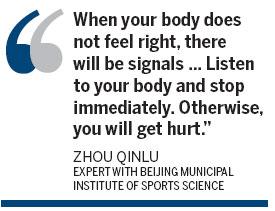Don't stretch yourself
Updated: 2013-07-10 07:18
By Liu Zhihua (China Daily)
|
|||||||||||

More Chinese are taking up yoga and a flood of studios teaching the discipline are opening across the country. But as Liu Zhihua finds out, inexperienced students may be risking strain and injury.
Yoga is now a mainstream exercise regime worldwide, a far cry from the 1960s and '70s when you had to go to a retreat in India to practice.
In the new millennium, it is gaining popularity at rocket speed in China. Although there are no authorized statistics on the number of yoga shala in the country, a simple search online for such a studio will pop out hundreds of results in any big city.
The country's urbanites have embraced yoga for exercise, relaxation and its health benefits. They believe the low-impact exercise can help them shape up and slim down, and view yoga as an alternative treatment for some physical and psychological conditions, such as joint and muscle-related pain, stress and depression.
But experts warn that yoga, like any other exercise, can inflict injuries that cause muscle strain, tear ligaments, or bring about even more serious injuries.
"With yoga's explosive popularity in China, there are many yoga instructors who lack the training necessary to recognize if students are headed toward injuries," says Zhou Qinlu, a fitness expert with Beijing Municipal Institute of Sports Science.
That's bad news for yoga students, as Zhang Huijie, a young woman in Shanghai, knows from personal experience.
She started practicing yoga at a famous studio in late 2012, taking part in normal yoga, and then in "hot yoga", a form of yoga that takes place in a room heated to 40 to 42 C.
Each session lasts 90 minutes, although Zhang usually manages to last about 60 minutes before feeling uncomfortable.
During a hot yoga class earlier this year, a new instructor insisted that she continued and stopped her from leaving. Zhang stayed.
Soon afterwards she started having difficulty breathing. She sat down on the floor, but her limbs became numb, she became breathless and she could not speak, or move.
"It was as if my body had frozen. I could hear the sounds around me, and I was conscious, but I couldn't move. Not even a finger," she recalls.
No one noticed her situation, and when they finally did, they rushed her out of the scorching hot room, called an ambulance, cooled her down with ice and fed her sugar water.
Half an hour later, she was able to get up and walk slowly, but she had struggled so hard to breathe that her chest ached the next day.
"I was scared. I felt so close to death for the first time in my life," Zhang says.

Zhang's symptoms were probably caused by dehydration and hypoxia, according to a Beijing yoga instructor Cheng Gong.
"Hot yoga is very demanding to a practitioner," Cheng explains. It is like doing strenuous activity in a hot and humid environment, and has certain health risks associated with the extreme heat, such as heat stroke, especially when the practitioner is not in a good health condition.
While Zhang's experience is extreme, it is true that yoga injuries happen more often and more easily than people think.
Cheng says students may easily strain, sprain and dislocate muscles, joints and ligaments if they don't perform exercises correctly.
Most yoga injuries are light, such as muscle strain, but there are also chronic and severe injuries accumulated over months or years because of incorrect posture. This may include injury to the cervical vertebra and spine damage, or retinal tears.
"Every asana, or yoga pose, has its mechanism and essential requirements," Cheng says.
"If students fail to get correct instruction, or if they don't follow the instructions, chances are they will end up with injuries.
"A good yoga teacher must be able to help students do the poses correctly, and not push them beyond their capabilities."
The teacher also needs to be able to detect the "danger zone" for individual learners, based on the individual's physical condition, Cheng adds.
The problem is many yoga instructors in China are not properly qualified.
Some rush into the profession only for the money, and may not have proper understanding and skills for yoga coaching, Cheng observes.
"These yoga teachers are very irresponsible," Cheng says.
Tang Xiaodi, 26, from Shanghai, has practiced yoga for nearly 10 years, and has never been injured from doing yoga.
She was surprised to hear her mother say that she hurt herself soon after taking up yoga.
Dong Hua, 54, joined a yoga class last year at a newly opened fitness center in her community in Dalian, Liaoning province.
The class had about 30 to 40 students, mostly middle-aged women. The teachers encouraged them all to adopt classic asana again and again, including headstands, shoulder stands, and downward-facing dog, in which the body forms an inverted V.
One day Dong felt a sharp pain in her shoulder while doing a headstand. The pain persisted and she decided to call her daughter, Tang.
"I was shocked to hear that her teachers had asked her to copy their stances, and that her fellow students had urged each other on.
"This was utterly different from what my yoga instructors teach me, that you do the asana as much as you can, but do not do it with ego or obsession, and do not strain yourself," Tang says.
In the end, Dong stopped her yoga classes for two months until her pain went away.
Zhou Qinlu, the fitness expert, says to avoid yoga injuries, the most important thing is to listen to your own body, not the teacher.
"Yoga is good, but your yoga teacher may not necessarily be good," Zhou says. "There is no government-authorized yoga instructor assessment system in China, and for novice learners, sudden high-intensity yoga exercise without good direction will definitely invite injury.
"When your body does not feel right, there will be signals, such as muscle twitches, spasms and sharp pain. Listen to your body and stop immediately. Otherwise, you will get hurt."
Contact the writer at liuzhihua@chinadaily.com.cn.
(China Daily 07/10/2013 page19)
Today's Top News
China, US hold talks on cyber security
China's foreign trade rises 8.6% in H1
Snowden has not accepted asylum in Venezuela
Teenage girls were best friends
Japan tags China as 'security threat'
Headwinds may buffet growth
QFIIs hope for expansion of program
Shenzhen Red Cross denies organ claim
Hot Topics
Lunar probe , China growth forecasts, Emission rules get tougher, China seen through 'colored lens', International board,
Editor's Picks

|

|

|

|

|

|





